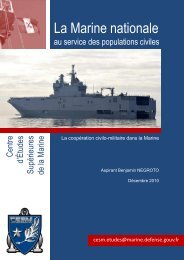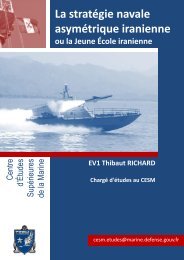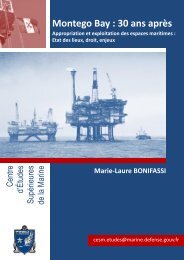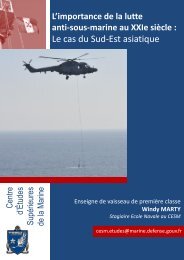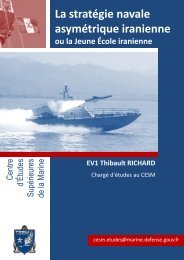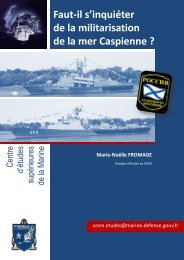2013 - CESM - ROYAL NAVY - English v2x
2013 - CESM - ROYAL NAVY - English v2x
2013 - CESM - ROYAL NAVY - English v2x
Create successful ePaper yourself
Turn your PDF publications into a flip-book with our unique Google optimized e-Paper software.
Vincent DESNOS<br />
Avril 2012<br />
In « Océans, enjeux de défense et de sécurité »<br />
“Royal Navy: Past resilience and future<br />
renunciation?”<br />
'<br />
Subjected to unprecedented austerity, the British Ministry of Defence (MoD) has had<br />
to undertake a Strategic Review (SDSR) in 2010 to compensate for cuts in its budget.<br />
The Review involved a reduction in the size of the Royal Navy and was a major turning<br />
point: fewer sailors, downgrading of equipment programs, and mainly early<br />
withdrawal of ships, including the aircraft carrier HMS Ark Royal. From March 11 th<br />
2011, the British Navy saw itself thus deprived of its fleet air arm, until the entry in<br />
service of the new aircraft carrier scheduled for 2020. Ironically, since then, the Royal<br />
Navy has been tapped more than ever. A week later, on March 19, the intervention<br />
began in Libya, involving the sending of sixteen British ships to participate in the<br />
NATO Unified Protector international operation. With no aircraft carrier to establish a<br />
no-fly zone over Libya, the British honourably waged air action from forward bases in<br />
the Mediterranean, but this recalled the bitterness of a Royal Navy left without the<br />
means of its ambitions by the SDSR. And now, thirty years after the start of the<br />
Falklands War which pitted for 75 days London and Buenos Aires, tensions have<br />
resurfaced about the string of islands in the South Atlantic and the black gold that it<br />
contains. Argentine bellicose attitudes are giving credit to the voice lamenting the<br />
downgrading of the Royal Navy to second tier.<br />
To analyze the impact of the SDSR on the operations of the Royal Navy, it is useful to<br />
introduce the concept of resilience. As is the case in France, where this concept is still<br />
exploratory 1 , it offers a good reading grid to address the means by which the Royal Navy is<br />
able to absorb the shocks and restore normal operation. In 1982, the restoration of British<br />
sovereignty over the Falklands showed strong resilience of the Navy. SDSR in 2010, Libya in<br />
2011 and the more recent posturing about the South Atlantic archipelago are all events<br />
assessed in the light of the resilience of the British navy. Is the Royal Navy still in a position<br />
to fulfil its roles? Does it still have adequate resources for its political and military objectives?<br />
Let’s first define resilience applied to the military and illustrate it with the Falklands War of<br />
1982, before analyzing the current and long-term format of the Royal Navy.<br />
‘<br />
I. The notion of resilience applied to armed forces<br />
The concept of military resilience was introduced from 2007 into British joint military doctrine<br />
and has been defined as “the means by which MOD units and establishments survive and<br />
recover from events, which significantly impair their ability to carry out normal functions." 2<br />
From a British point of view, it means special attention is paid to the ability to provide ongoing<br />
and sustainable support to overseas operations. In France, the 2008 White Paper on<br />
1 The concept of resilience was introduced in 2008 in the White Paper on Defence, and has since been a<br />
reflection of CICDE about possible implications for the armed forces<br />
2 Joint Doctrine Publication 02, 2007, "Operations in the UK: The Defence Contribution to Resilience", second<br />
edition, pp. 2-36
defence and national security provided a definition of military resilience for the first time,<br />
relatively similar to the British one. The CICDE then presented an exploratory concept to<br />
describe the fundamentals and principles as well as the overall process. The French define<br />
resilience as “the willingness and ability of a country to withstand the consequences of an<br />
attack or major disaster, and then quickly restore their ability to function normally, or at least<br />
in a socially acceptable way. " 3 The resilience effort should involve both capability and<br />
willingness, and include men, organization and equipment. A fundamental condition of<br />
resilience is the ability of the actors, structures and equipment to act in spite of degraded<br />
situation. Resilience is the result of a "dynamic process, over time, to be understood in all its<br />
phases" 4 : the preparation which conditions the subsequent ability to resist, the resistance<br />
itself, the restoration of a normal situation and the long-term consolidation.<br />
II. A model of resilience: The "Falkland effect" of 1982<br />
The Falklands crisis of 1982 illustrates effective resilience of the Royal Navy, and more<br />
broadly of the United Kingdom. The origin of the conflict that broke out in April 1982 between<br />
London and Buenos Aires is a 19th century dispute about the sovereignty of the islands of<br />
the South Atlantic, owned by London but claimed by Buenos Aires. By focusing its public<br />
opinion on the issue of Argentine Falklands, the military junta in power since 1976 was able<br />
to distract it from the failure of its policies as it was unable to stem the serious economic<br />
crisis Argentina was faced with. For their part, the British dithered about the protection of the<br />
islands and had stripped their defence. The 1981 strategic review had decided a few weeks<br />
prior to the conflict to remove the last unit of the Royal Navy of the islands, and (already)<br />
proposed the decommissioning of the aircraft carrier, no decision yet being made at the<br />
outbreak of the conflict 5 . Argentines therefore took advantage of this degree of British<br />
uncertainty and the invasion of the islands began April 2, 1982. The reaction of Prime<br />
Minister Margaret Thatcher was firm. Supported by the British public, intervention was<br />
decided to restore British sovereignty over the Falklands. In less than five days, a British<br />
carrier battle and amphibious group had assembled then left Portsmouth bound for the South<br />
Atlantic. The naval battle began on May 1, and the troops of the Royal Marines landed on<br />
May 21. On 14 June, the Argentine garrison stationed at Port Stanley was officially defeated,<br />
and the cessation of hostilities declared by the British on June 20. The fighting rose to 652<br />
dead, 1136 injured, eight sunken ships and 101 aircraft destroyed on the Argentine side, and<br />
255 dead, 777 wounded, 6 ships sunk, 34 aircraft destroyed on the British side.<br />
For the Royal Navy, the war of 1982 shows a resilience process. Unpreparedness could<br />
have been disastrous, but the process ultimately proved operating. The ability to avoid<br />
strategic surprise supposed monitoring capabilities and a performing alert system. But in<br />
1982, the British intelligence services had only a vague idea of Argentine intentions 6 .<br />
Vulnerabilities were not identified, as evidenced by the withdrawal of units of the Royal Navy<br />
from the Island shortly before the invasion. The poor initial decisions of the British thus<br />
facilitated invasion by the Argentines, but their resilience allowed restoring the initial status<br />
quo.<br />
The first signs of resilience showed in the immediate response capability of the Royal Navy<br />
and the British forces. Following the invasion, London reacted with firmness and organized<br />
diplomatic pressure on Buenos Aires. Concurrently, the military preparations were made<br />
quickly in order to set up the intervention force as soon as possible and independently. The<br />
3<br />
LBDSN 2008, cited in the joint exploratory concept "Resilience" of CICDE (No. 202/DEF/CICDE/NP<br />
December 12, 2011)<br />
4<br />
CICDE, December 2011, Joint Concept exploratory "Resilience", No. 202/DEF/CICDE/NP p. 37<br />
5<br />
Goussot C., B. Gomis, March 29, 2012, "Grande Bretagne - France: the new deal," available at<br />
http://www.marine-oceans.com/geopolitique/71-grande-bretagne-l-france-la-nouvelle-donne<br />
6<br />
Clarke M., 2012, "The Falklands: The Security Equation in 2012", available at<br />
http://www.rusi.org/analysis/commentary/ref:C4F6324444BE2E/
firm reaction of the British therefore enabled to contain the deteriorating situation. The first<br />
military actions followed unsuccessful attempts of UN mediation, ensuring continuity in<br />
action. With no base near the conflict area, the British pre-positioned their forces on<br />
Ascension Island in the middle of the Atlantic. This forward base served as a relay for the<br />
Royal Navy and provided support to the battle group (the Falklands are located 13,500<br />
kilometres off the British coast, and only 480 km off the Argentinean coast). Finally, the Royal<br />
Navy managed to overcome the high numerical inferiority of its air cover (only 14 Harriers on<br />
board, versus 120 lined up by the Argentine side, of which 50 dedicated to air superiority).<br />
The breaking point was reached on May 3 when the HMS Conqueror SSN (nuclear-powered<br />
attack submarine) sank the Argentine cruiser Belgrano. This torpedo was of strategic<br />
importance because it eliminated the Maritime Argentine threat, with its entire fleet<br />
subsequently hiding in ports.<br />
Ex post, the British were able to learn from the fighting experience and from the<br />
unpreparedness which could have been fatal. After 1982, a considerable investment of 700<br />
million pounds allowed to build a large military base around a new airport in Mount Pleasant.<br />
Nearly 1,500 soldiers station there permanently, as opposed to 80 at the time of the invasion.<br />
Today, four Typhoon fighters provide air defence, with the RAF effectively relaying the Royal<br />
Navy. The British Navy has thus been able to develop a form of hyper-resilience despite the<br />
loss of several warships and an environment that was unfavourable. What’s more the<br />
Thatcher government was able to take advantage of the crisis, and benefited from what<br />
should be called the "Falklands effect", a popular support to its effective management of the<br />
crisis which allowed it to win the elections the next year.<br />
III. Program review and current issues: the complex equation of resilience<br />
The Strategic Defence and Security Review (SDSR)<br />
In October 2010, the National Security Council announced its Strategic Review of Defence<br />
and Security (SDSR), whose findings would impact the format of the British defence. This<br />
document has made concrete suggestions to achieve the savings required from the MoD by<br />
the austerity plan that the coalition government of Tories and Libdem implemented in 2010<br />
after the parliamentary elections. The savings for Defence have been set at about 8% in real<br />
terms over the period 2011-2015, thus stabilizing the defence budget at around 34 billion<br />
pounds.<br />
The conclusions of the SDSR had a significant impact on the capabilities of the Royal Navy,<br />
with immediate effect in certain areas. Restructuring of the Navy contained several<br />
measures. First, the withdrawal of the Navy fleet of Harrier aircraft with vertical / short<br />
takeoffs and landings, and the early withdrawal from active service of the aircraft carrier HMS<br />
Ark Royal, thus depriving the Royal Navy's of its fleet air arm until at least 2020. Its<br />
application was immediate. Then, the reduction of the number of frigates by early withdrawal<br />
of four of them, reaching a final number of 19 frigates (types 23 and 26) and destroyers (type<br />
45). In addition, the SDSR put on standby the helicopter carrier HMS Ocean, and retired from<br />
active duty the light aircraft carrier HMS Illustrious. Finally, the staff of the Royal Navy is<br />
being reduced by 5000, reaching 29,000 seamen by 2015.<br />
Confusion about the future aircraft carrier Queen Elizabeth class<br />
While the SDSR continued building two aircraft carriers, uncertainty remains about their<br />
technical specifications, their date of entry into service and operational number. The initial<br />
configuration of the first aircraft carrier of the Queen Elizabeth class whose construction<br />
began in July 2009 was due to carry the STOVL version (short takeoff and vertical landing) of<br />
the F35B Joint Strike Fighter, which meant a flight deck without catapults and stopping wires.<br />
Unveiled by the SDSR in 2010, the choice for the Royal Navy changed in favour of a<br />
CATOBAR version for both aircraft carriers to accommodate the F35C. This choice was
motivated by the better capabilities of the C version (longer range, higher payload capacity),<br />
as well as the desire for interoperability with U.S. and French navies. Only one aircraft carrier<br />
would have been operational, the Royal Navy not being able to operate both with 29,000<br />
seamen 7 . In November 2011, another change confirmed the use of the CATOBAR version<br />
for one aircraft carrier only, the Prince of Wales. The Queen Elizabeth, scheduled for 2016,<br />
would be used to qualify the crews awaiting the arrival of the second aircraft carrier from<br />
2020. Two hundred sailors and airmen would train in parallel on the French and the U.S.<br />
aircraft carriers to develop their takeoffs and landings skills. Crews would therefore be<br />
operational in 2020 on the Prince of Wales, while the Queen Elizabeth would be placed in<br />
reserve in accordance with the SDSR, and later possibly benefit from a retrofit or be resold.<br />
However, more recent reversals maintain confusion as regards the naval capacity. The cost<br />
of converting a single aircraft carrier to CATOBAR system would be about 1.8 billion<br />
pounds 8 . Already at a financial impasse, the MoD should find some £ 300 million more per<br />
year for six years, which would compromise the confirmed order of F35B. Stay tuned.<br />
Intervention in Libya: shortness of resilience<br />
Triggered at very short notice, the Unified Protector NATO operation tested the<br />
responsiveness and resilience of the Royal Navy. This operation demonstrated the high level<br />
of preparedness of the navy and the endurance of the equipment. But it also revealed the<br />
limitations and shortcomings of a material that has been used up to its limits for a relatively<br />
long period considering the initial unpreparedness. While the fleet has proved resilient, most<br />
of the sixteen vessels engaged in Libya are still docked for technical stop, thus depriving the<br />
Royal Navy of a significant presence in the sea. Recovery capabilities of the fleet are thus<br />
impacted and resilience is less effective.<br />
Thirty years after the war, renewed tension on Falklands<br />
Since 2010 the Falklands crystallize tensions between London and Buenos Aires once more.<br />
The British government has authorized oil exploration and the British Geological Survey has<br />
established that the Falklands reserves would amount to 60 billion barrels, much similar to<br />
those of the North Sea 9 . Early 2012, the deployment of new missile destroyer HMS<br />
Dauntless and of a new SSN, as well as the arrival of Prince William in the Falklands are<br />
many provocations that justified in the eyes of Buenos Aires the February 2010 complaint to<br />
the UN to denounce the militarization of the conflict by the United Kingdom. However, the<br />
seriousness of the escalating conflict should be relativised, as war outcome seems highly<br />
unlikely. For the moment, it is just posturing, diplomatic one on the Argentine side, and<br />
military on the British side. Its symbolism is certainly strong, but it’s not likely to escalate into<br />
open conflict. The Argentine government is not comparable with its military predecessor,<br />
politically beleaguered in 1982. Military adventurism does not seem relevant, especially as<br />
the Argentine military equipment is aging and that bilateral trade between the two countries<br />
amounts to 1.4 billion pounds. 10<br />
If an Argentine attack seems very unlikely today, concerns remain high on the British side. In<br />
November 2010, a group of former admirals of the Royal Navy reacted to the political<br />
decision to scrap the aircraft carrier Ark Royal and her fleet of Sea Harriers 11 , saying the cuts<br />
were a virtual invitation made to Argentina to attack the Falklands, which would impose a<br />
7<br />
Defencemanagement website, November 25, 2011, "Navy will be too small for two carriers", available at<br />
http://www.defencemanagement.com/news_story.asp?id=18127<br />
8<br />
Defencemanagement website, March 13, 2012, "Carrier conversion could cost £ 1.8bn", available at<br />
http://www.defencemanagement.com/news_story.asp?id=19140<br />
9<br />
Brèves Marines, March 13, 2012, « Iles Malouines : les forages de la discorde », N°143 ("Falkland Islands:<br />
drilling of discord")<br />
10<br />
« The Falklands : The Security Equation in 2012 », op. cit.<br />
11<br />
BBC News UK, 10 November 2010, "Admirals urge rethink on Harrier and Ark Royal cuts", available at<br />
http://www.bbc.co.uk/news/uk-11723589
national humiliation in the UK worthy of the loss of Singapore 12 . According to them, if<br />
Argentina were to take the islands, the British would have absolutely no way to get them<br />
back. They did not hesitate to compare this ten year rule imposed by the Government (ten<br />
years without naval capacity) to the previous ten-year rule of the 1930s which cost "freedom<br />
from Hitler." Or to compare the 2010 strategic review to the 1981 one, the same causes<br />
producing the same effects. The government may play down the consequences of the loss of<br />
the fleet air arm capability, it nevertheless remains cautious. This is evidenced by<br />
deployments in March of HMS Dauntless and a SSN as part of the strategy for preventing<br />
any dispute over the Falklands. The destroyer is the projection from the sea of British power<br />
in deterrence logic. The presence of the SSN in the South Atlantic waters illustrates a<br />
strategy of denial of access, preventing Argentine control over the maritime area without<br />
forcing the British to control it themselves. The British therefore display a strong preparation,<br />
coupled with strong political will not to be surprised again. It is indeed resilience in its<br />
preparatory phase.<br />
IV. Eventually, renunciation of power projection but resilient force projection<br />
Although the capabilities of the Royal Navy to conduct amphibious operations have been<br />
reduced in the short term, the Strategic Review seems to strengthen them in the long term.<br />
The concept of adaptable strategic posture indeed gives priority to the prevention of<br />
international military crises, with the ability to respond if they occur. The strategic review thus<br />
explicitly recognizes the need for and usefulness of the amphibious capability, while the<br />
response to an unlikely but high-risk wide scale attack is devoted to nuclear deterrence<br />
Maintaining amphibious capability is embodied in the development of a rapid reaction force<br />
('High Readiness Response Force'), whose key element is the Royal Marines corps and its<br />
three brigades of commandos. SDSR therefore plans to project and sustain a group of 1,800<br />
soldiers and their equipment from the sea. For that purpose, the helicopter carrier HMS<br />
Ocean was maintained in preference to the light aircraft carrier HMS Illustrious because it<br />
provided more benefits for force projection 13 .<br />
Force projection should be not only maintained but reinforced with the arrival of the future<br />
aircraft carrier. In conventional deployment, she will carry only 12 combat aircraft, against 36<br />
as originally planned (the payload is still maintained). This will enable it to carry more<br />
helicopters, both transport (up to 12 Chinook or Merlin) and attack helicopters (8 Apaches).<br />
In this configuration, the future aircraft carrier Queen Elizabeth Class would rather be used<br />
for force projection. The amphibious component could therefore prove more resilient than<br />
expected. In contrast, the Royal Navy would relinquish power projection fully until 2020, and<br />
at least partially beyond that date.<br />
In the past, the Royal Navy showed resilience and has been able to gain benefits from the<br />
shocks it had to endure. But today, the SDSR has impacted its capabilities in an<br />
unprecedented way, including its fleet air arm. While the media air time is focusing on the<br />
display of forces between Argentina and the United Kingdom because of heightened tension<br />
on the Falklands, while critics are going well against a British government accused of<br />
sacrificing the Royal Navy, it is possible that the real issue is not so much about the current<br />
capabilities of the Royal Navy but about the possible strategic change in its future<br />
employment. The movement launched by the SDSR which refocuses on the Royal Navy<br />
amphibious capabilities and which seems to be confirmed by the latest configuration of the<br />
new aircraft carrier suggests that in the future policymakers will favour force projection to<br />
projection of power. This shows the resilience of one capability against the partial<br />
renunciation of another one.<br />
12<br />
The surrender of Singapore to the Japanese forces in February 1942 is considered one of the most crushing<br />
defeats of the British army.<br />
13<br />
RDS Interview, August 2011, "Maintaining the UK's Maritime Expeditionary Capability Post SDSR",<br />
available at http://www.rusi.org/downloads/assets/RDS_201101_Michell2.pdf



